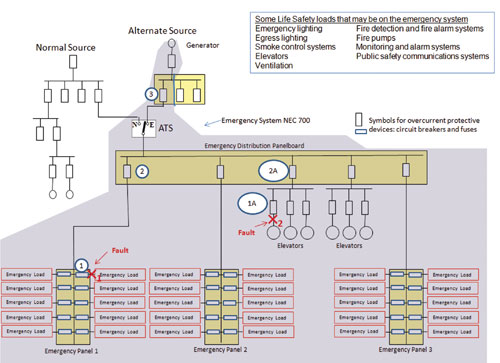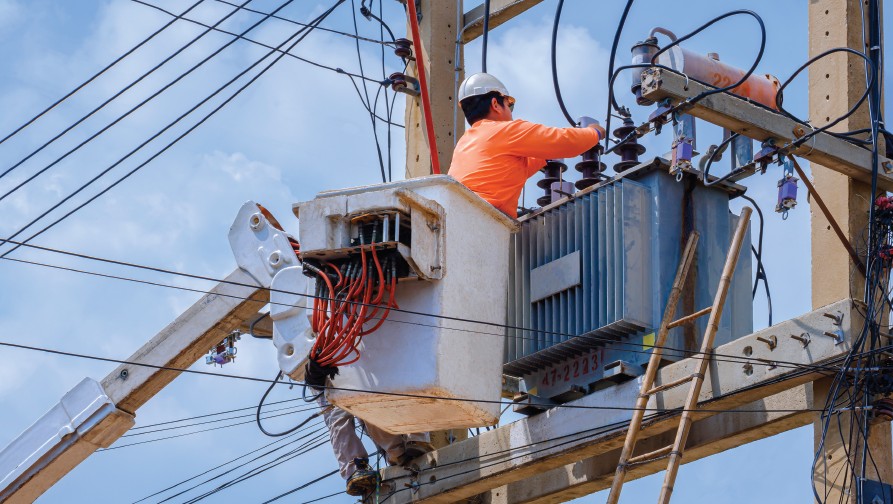 What matters to a person when they are in a facility that has capacity for many people and an emergency situation such as fire, flooding, storms, earthquake, explosion, or merely loss of normal utility electrical power occurs? Naturally, this depends on the situation, but the basic human instinct is to want to escape the event without physical or extreme emotional trauma. We desire safety for our family, ourselves, and others.
What matters to a person when they are in a facility that has capacity for many people and an emergency situation such as fire, flooding, storms, earthquake, explosion, or merely loss of normal utility electrical power occurs? Naturally, this depends on the situation, but the basic human instinct is to want to escape the event without physical or extreme emotional trauma. We desire safety for our family, ourselves, and others.
In buildings where large numbers of people can assemble, such as office buildings, schools, high rises, hotels, theatres, arenas, and hospitals, there are electrical loads that are intended to provide for human safety in emergency situations. The 2012 NFPA 101 Life Safety Code provides minimum life safety requirements for the design, operation, and maintenance of buildings and structures. Examples include emergency loads such as elevators, emergency lighting, emergency egress lighting, alarm systems, ventilation, smoke control, fire pumps, and more. These life safety loads need to operate when there is an emergency and need to operate as long as possible, even if the building and electrical system supplying these loads are under physical distress. And if a portion of the electrical system is damaged due to fire or other causes, it is imperative to restrict any resultant electrical outage to the minimum portion of the electrical system thereby keeping as many vital loads powered as possible. Lives may depend on these loads.
A key requirement for the electrical systems that power these life safety loads is reliability. It is superior to that typically provided for ordinary loads and thereby increases the probability people can survive or escape during emergency events. The reliability of electrical systems supplying life safety loads and functions is just as important and possibly more so for first responders. Merely relying on the normal system does not provide sufficient continuity of electrical power for life safety. Additional alternate electrical source(s) (in case the normal source is lost) and an electrical distribution system designed, installed, and maintained to be more reliable are necessary. Components such as generators, automatic transfer switches, and circuit wiring with higher reliability features are needed. This increases the cost, space requirements, and design, installation, and maintenance complexity of the facility electrical system. But not having these could mean loss of life or severe injuries if an emergency event occurs.

Figure 1. This overly simplified electrical distribution system one-line depicts the various circuits and panels. Each emergency panel may have one or more life safety type loads or functions with one or many branch circuits for each life safety function.
There is an ever continuing trend to utilize more and increasingly sophisticated life safety and emergency electrical functions. In other words, for facilities where large numbers of people assemble, there are more emergency loads with more complexity and interdependencies. Elevators have long been used for transporting first responders and their equipment. However, now in some cases, elevators are being used for emergency egress of building occupants; the 2012 NFPA 101 has added new requirements for occupant evacuation elevators. Now there are sophisticated public safety communication systems, fire detection and alarm systems, and more. As you walk in the middle of a large unfamiliar building at night ask yourself what you would do if a major fire or explosion ensued and all the lights go out, and none of the life safety loads functioned.

Figure 2. Cascading overcurrent protective devices will result in unnecessary loss of power to other life safety loads.
The 2011 NEC has minimum installation requirements for the electrical systems supplying these vital life safety loads. These minimum requirements provide the baseline for the electrical system reliability. Systems can be designed and installed for more reliability than the NEC requirements, but the minimum NEC requirements must be met and not compromised.
The bottom line is that if it is your family at the top of a high rise building during a major fire, their path of egress to safety relies heavily on the electrical system. Whether the normal source or the emergency source is supplying the power to the life safety loads, come “hell or high water,” your family’s fate may very well be in the hands of the electrical system. If they are on the 20th floor and have to exit via a stairway, will the egress lighting be operational to illuminate their pathway? Will the smoke control system keep the stairway free of smoke so they can survive? Will the public safety communication system be powered to deliver vital messages to assist in their journey to exit the building or to a safe location? Will the elevators be powered so the first responders and their equipment can quickly get to where they need to be and they can move quickly to other locations? The answer to these questions lies within the integrity of the “emergency system.”
If fire, smoke, or physical damage to the building causes a fault in the emergency electrical system, will the fault be localized to only the faulted circuit, or will multiple levels of overcurrent protective devices cascade open and unnecessarily cause loss of power to life safety loads? Remember, it could be your family relying on the integrity of the electrical system to ensure their pathway to safety.
The authority having jurisdiction (AHJ) has an important role. They very well could be the last line of defense against an electrically compromised pathway to safety. From an enforcement standpoint, those responsible for approving the electrical installation have the responsibility to ensure the minimum requirements are met for these vital life safety systems. If AHJs are able to review the plans and installations and ensure code-compliance, your family has an increased probability of coming home if ever they are caught in a building when an emergency event occurs. In some cases, the AHJ has to establish the “interpretation of the rules” per NEC 90.4 which is an especially significant responsibility when it concerns the emergency electrical system.
It is important to mention that besides the NEC and NFPA 101, there are other applicable codes and standards that are not mentioned in this article but that have relevant requirements for specific life safety functions, systems, or loads.
Systems Vital for Life Safety
The societal demands upon modern building life safety are necessitating more life safety systems, more interdependency of various electrical functions which are supplied by emergency systems, and greater reliability.
Elevators are an example. In normal conditions elevators are a convenience to move people vertically in a building. Over the decades, we have been educated not to use the elevators during fires. However, elevators can have the provision for first responders to take control of elevators for improving their speed of response. In some cases, elevators might only be supplied by the normal electrical system and have no provision for emergency power. In other cases, elevators may be on the emergency system and therefore supplied by either the normal or emergency source, depending on the circumstances.
However, in emergency conditions elevators are now permitted to serve as occupant evacuation elevators (2012 NFPA 101 7.14) if approved by the AHJ and if all requirements are met (includes NFPA 101, NEC, and others). The NFPA 101 requirements include the emergency command center continuously monitoring and displaying the elevators, elevator lobbies, elevator machine rooms, and status of many related functions serving the elevator system. The following are a few such interdependent functions powered by the emergency electrical system. The lobbies of occupant evacuation elevators must be equipped with a status indicator display system to communicate visually to occupants the condition of use: (1) normal use, (2) available for occupant evacuation, or (3) out of service – use the stairs.
If elevators are used for occupant evacuation, then the building must be protected throughout with a fire alarm system and a voice/alarm communication system with capability to give voice directions on a selective basis to any floor. In addition, occupant evacuation elevator lobbies must be equipped with a two-way communication system to permit communications between persons in the elevator lobby and the emergency command center or another designated location. This illustrates the level of sophistication modern building life safety systems may have; there are multiple interdependent systems vital for human safety that are powered by the heart of the electrical system, the “emergency system.” Losing one or more of these systems reduces the probability the occupants will survive.

Photo 1. This photo was taken by Mark Hilbert after an earthquake in Hawaii. The entire island was without power because the utility generators sensed the movement and shut down. The only thing illuminated in the entire hotel was the stair tower.
There are many other life safety electrical loads or systems that may be deployed in a building. These can include fire pumps, emergency lighting, egress lighting, smoke control systems, fire detection and alarm systems, communications systems, video systems, ventilation, HVAC for specific applications, monitoring various electrical functions and other functions.
Reliable Electrical Power
Reliable power supply and reliable electrical circuits for life safety loads are vital. The NEC has specific requirements for fire pumps in Article 695 and elevators in Article 620. In addition, Article 700 Emergency Systems, Article 701 Legally Required Systems, and Article 708 Critical Operations Power Systems provide requirements for electrical distribution systems that demand more reliability than normal systems.
Per NEC Article 700, the life safety loads and systems are powered by the normal electrical source and, in addition, with one of the type emergency electrical power sources complying with 700.12. So in simple terms, life safety loads or functions are powered from an emergency electrical distribution system which is supplied by a normal source and an emergency source. There can be a wide variance in the electrical distribution system layouts based on the building type and life safety loads or functions required by the AHJ or by chosen design. Figure 1 is an overly simplified electrical distribution system one-line depicting the various circuits and panels. Each emergency panel may have one or more life safety type loads or functions with one or many branch circuits for each life safety function. So what makes NEC Article 700 emergency systems more reliable than normal NEC electrical systems? In addition to complying with Chapters 1 – 4 of the NEC, emergency systems must comply with NEC Article 700 which can supplement or modify Chapters 1 – 4. In addition, there may be requirements applicable for an emergency system from Chapters 5 for Special Occupancies, 6 for Special Equipment, and other Chapter 7 articles for Special Conditions. The following discussion will highlight some of the key Article 700 requirements that provide the increased reliability to power life safety loads.
700.3 Requires AHJ witnessed testing of the emergency system upon installation and periodically.
700.4 Capacity and rating for simultaneous operation of all loads. All equipment must have short-circuit ratings equal to or greater than the available fault current and all overcurrent protective devices must have interrupting ratings greater than the available fault current.
700.5 Automatic transfer switches and all transfer equipment shall be identified for emergency use.
700.10 All boxes and enclosures must be permanently marked as part of an emergency circuit or system. Emergency circuit wiring must be separated from other wiring. Wiring must be located to minimize failures due to adverse conditions such as flooding, fire, etc. There are special fire protection requirements for some occupancies which may require a two-hour fire rating.
700.12 If normal power is lost, emergency power shall be available to loads within 10 seconds. This section provides the type of alternate power sources that may be used. The specific type of alternate source utilized is typically based on the performance required by the NEC and other codes and standards predicated on the type occupancy and type of service required.
700.15 Emergency lighting branch circuits can only supply lighting designated as required for emergency use.
700.16 The failure of one lighting element must not result in total darkness to any space requiring emergency illumination. This is an extremely important element (no pun intended) that ensures that while under emergency conditions, the objective of avoiding spaces without illumination is met.
700.20 Only authorized personnel shall have control of emergency lighting.
700.25 Only authorized personnel may have access to emergency branch circuit overcurrent protective devices.
700.26 Ground fault protection with automatic disconnecting means, as required by 215.10, is not required for the alternate emergency source. This is an important permission since this relegates the delivery of power to life safety loads at a higher priority than the damage resulting due to a ground fault. However, if this permission is granted then ground fault indication is required in accordance with 700.6(D).
700.27 “Emergency overcurrent protective devices shall be selectively coordinated with all supply side overcurrent protective devices.” This requirement is especially important when the emergency is a fire, explosion, earthquake, or similar event which may increase the risk of a fault on a circuit. Fires may cause the ionized gases to initiate a fault in equipment or the resulting high temperature may result in a short circuit. Earthquakes and explosions can cause faults in equipment and circuits as well. If the installed overcurrent protective devices are not selectively coordinated for all levels of available fault current, a fault on one part of the system may unnecessarily cascade two or more levels of overcurrent protective devices upstream. Cascading overcurrent protective devices will result in unnecessary loss of power to other life safety loads.
See figure 2. A branch circuit fault such as X1 or X2 should only be cleared by the branch-circuit overcurrent protective device (1 or 1A, respectively). No feeder overcurrent protective devices upstream should open for a branch-circuit fault (X1 or X2). If a branch-circuit fault X1 unnecessarily opens the feeder 2 overcurrent protective device, an entire emergency panel will be without power versus only the life safety load(s) on the faulted branch circuit 1. Or if branch-circuit fault X2 unnecessarily opens the feeder 2A overcurrent protective device, a whole bank of elevators will unnecessarily be without power versus only the one elevator on the faulted branch circuit. If the cascading goes even higher in the system, such as when feeder 3 overcurrent protective device unnecessarily cascades open for a branch-circuit fault (X1 or X2), all the emergency loads will unnecessarily be without power. The unnecessary opening of overcurrent protective devices can jeopardize the life safety of the building occupants and first responders who may need those specific life safety loads.
Summary
People’s lives depend upon the emergency power sources and emergency distribution systems delivering power to life safety loads during emergency situations. In essence, emergency systems are “insurance” that people are more likely to survive an emergency event, but there is a price to pay for this reliability. All the extra electrical equipment it takes to comply with NEC Article 700, Emergency Systems, has costs plus the additional cost for the associated engineering, installation, and maintenance. However, the bottom line is that it’s going to be someone’s family member on the 20th floor of that building during a fire, earthquake, explosion, or other emergency situation that has to find a pathway to safety. If it was your family member, wouldn’t you want these systems designed, installed, inspected and maintained as required?










Find Us on Socials